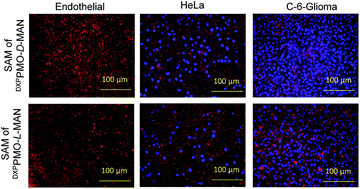Self-assembled monolayers of enantiomerically functionalized periodic mesoporous organosilicas and the effect of surface chirality on cell adhesion behaviour†
Abstract
In biotechnology, self-assembled monolayers (SAMs) of functionalized nanoparticles are of high interest as two dimensional (2D) surfaces to study cell–surface interactions. In this contribution, enantioselective functionalization of fluorescent dye loaded periodic mesoporous organosilicas (PMOs) with D(L)-mannose (MAN) and the preparation of the respective SAMs are described and the stereoselective interactions of these monolayers with different cell types are demonstrated. Cells do not only recognize the type of the surface functionality but also differentiate the surface chirality, which is much more pronounced in the presence of serum. Moreover, SAMs of PMO surfaces are used for the selective separation of malignant HeLa or C-6-Glioma cells from healthy endothelial cells. Finally PMOs are used as nanocontainers to deliver fluorescent dye molecules, as proof-of-principle for drug molecules, to the adhered cells on the SAM of PMOs.


 Please wait while we load your content...
Please wait while we load your content...